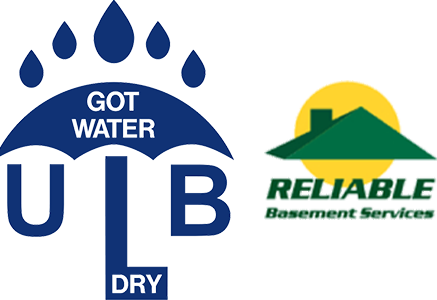In order to better understand some of the reasons why concrete basement walls will develop foundation cracks we first need to look at the concrete itself.
Concrete is composed of 4 major elements. Component number one is an aggregate , which is usually a fine sand and a stone or gravel base. Next is the cement powder base, a mixture of calcium, silicone, aluminum and iron. Then a chemical catalyst is added to promote curing. The final ingredient is water, lots of water. On average there will be 6 gallons of water per unit of cement mixture to create a cubic foot of concrete. There are 27 cubic feet in a cubic yard. For example a basement 24 by 24 with 8 foot tall walls at 10 inches will require approx. 24 cubic yards of concrete as well as over 3000 gallons of water. As that water cures out there is the possibility shrinkage cracking will occur. Increasing the volume of water to 8 gallons per unit will result is about a 40 % loss of compressive strength to the overall finished product.
Other factors such climate conditions and the existence of re-enforcing metal bars can also play a part in the formation of foundation wall cracks. If the weather to wet or cold the concrete may cure to slowly to hot and dry and the concrete may cure too rapidly. Re-enforcing bars ,know as rebar, are designed to limit movement and cracking. Most residential homes do not have re-enforcing rebar incorporated into the foundation pour. However foundation wall cracks are not the only points that water may leak into the basement through the wall. Two of the other additional issues are old tie form holes and honey combing. When the foundation walls are poured there are a metal rods used to hold the inner and outer wall forms together. After the forms are pulled the tie rods( as they are called) are snapped off next to the foundation. Over time excessive moisture will cause the metal to rust away leaving an open gap for water seep through. Honey combing refers to a portion of the foundation were the concrete was not properly shifted as it is was poured. The end result is a gravel pocket were the finer cement mix did not get incorporated into the aggregate leaving open gaps for water egress to occur.
Generally once foundation wall cracks develop they do not have the ability to cure or heal themselves .Over time as the soil around your home expands and contracts, as a result of the natural weather cycles, it exerts additional pressure on the foundation. It is the added pressure along with excessive ground water, caused by storm water runoff, combined together will open the cracks enough to become an issue. Basement seepage through foundation wall cracks and other deformities in the poured concrete can be treated either from the interior or the exterior depending on conditions.
If the wall is accessible from the interior then an epoxy injection method can be utilized.
This will entail opening several locations along the length of the break where the foundation crack is clear and visible. A series of ports are secured in place over the void. Any exterior portion of the crack, which is visible, is covered to prevent the resin from draining out prior to curing. An epoxy resin is injected into foundation crack. Once all the injection is complete the crack has literally been eliminated and the wall bonded back together. In cases where additional movement is anticipated a urethane can be substituted for the less forgiving solid epoxy.
An exterior technique is also available to resolve basement seepage through foundation wall cracks. This application will involve excavating a hole from finish grade down to top of footer. The wall surface is cleaned to expose the crack. A rubber based membrane is applied over the crack. With the application of this system on the exterior face of the wall the water egress has been cut off before it has a chance to enter the crack. While the flexibility of the membrane will absorb minor shifts and movements of the wall preventing the crack from re-opening.
Likewise both tie rod leaks and honey combs can be repaired from either the interior or exterior. However in some cases it easier to these smaller issues from the inside where the problem is readily accessible rather than excavate a large hole to expose a single location.
Despite the fact that foundation wall cracks are inevitable you rest assured not all of them will leak. However you be one of the unlucky homeowners who’s crack do develop seepage, there are
in-expensive, proven methods of repair available.
Written by Walter Slowinski





